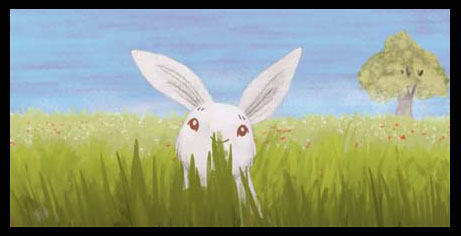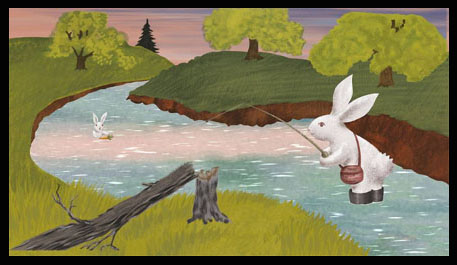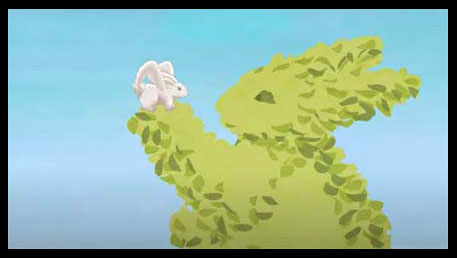
Amy Schatz is the eight-time Emmy-winning director of the new animated special The Runaway Bunny. This adaptation of the classic book, featuring new renditions of classic songs, is now streaming on HBO Max. Schatz discusses the casting, music and animation choices that went into making this, as well as the themes people of all ages can appreciate.
Jackson Murphy: You’ve had a great relationship with HBO over the years. How did the idea of wanting to turn this classic book into a special originate?
Amy Schatz: We made a film based on Goodnight Moon many years ago for HBO, which of course is the other very well-known classic by Margaret Wise Brown and Clement Hurd. And it had been a dream to do a follow-up with that. We’ve been talking with the estate about The Runaway Bunny for year after year thinking that we’d love to make a film based on that one. It just magically happened this past year. We really loved entering into this bunny world and trying to figure out how to replicate the magic of the book.

JM: You do it so well. How much studying of the book goes into making a special like this? Are you constantly reading it over and over again and dissecting it… and analyzing the illustrations?
AS: It’s interesting. It’s not only about the illustrations, but on that front, we really wanted to be true to Clement Hurd’s beautiful, magnificent, illustrations. The animation team really had to study what was going on with those bunnies. And what we learned about Clement Hurd’s approach to rabbits is that he has a different rabbit on every page. They look very different. His style is very loose. To try to capture that… we wanted to stay in his world and not venture too far from that. Maciek Albrecht and his team… there was a lot of trial and error and keeping the looseness of Clement Hurd’s work but also trying to have a consistent bunny look. There was that. And in terms of the meaning and the depth of the book, I feel like picture books have deep meanings, and in this one it seemed to be not only a simple story of a little bunny and his mama bunny in the grass doing this playful rhyming chase game, but also a story about growing independence, growing up, about childhood and parental love. There was a lot of psychological talk while we were working on this about how to capture that relationship and to do it right.
JM: I think this will do very well not only for Easter but also Mother’s Day. You collaborate with Tracee Ellis Ross. She’s the narrator and she sings in this as well. She was good doing all the songs in The High Note. What made you choose her?
AS: The quality of the voice. There aren’t very many lines, and we didn’t add any dialogue. It’s an exact transcription of the book. Tracee brought this incredible, sensitive, poetic, calming quality to it, which is what we wanted. Also, the mama bunny sings a lullaby in this film. Tracee so beautifully sang that lullaby. The interesting thing about the song is that Margaret Wise Brown had written this song and it really has been lost to history. It appeared in the first edition of the book but it never carried through over the past 80 years of this book’s publishing life. It’s the first time that we’re hearing this, and I think she did a beautiful job.

JM: Yeah. And wow – what an opportunity for the song to be a part of this after all this time. You also bring in Mariah Carey, Ziggy Marley and Rosanne Cash. I watched Rosanne in the My Darling Vivian documentary last year, which is incredible. And they’re doing new renditions. How did you approach asking all of them to be involved and to do new renditions of classic songs?
AS: We wanted the songs to really be love songs, and they’re all these classic, great songs about love and wonder. When we mentioned The Runaway Bunny and the idea of the project and it being about love and childhood, they all unanimously said, “Yes! We’ll do this. Sign us up.” Not only are they extraordinary artists, but they also had a connection to this beloved book that is something that’s for every generation. It’s not just about today or little babies/toddlers, it’s also for parents and grandparents. The artists sang these deeply heartfelt and beautiful classic songs, and that’s part of the storytelling.

Amy Schatz
AS: I’ve always been attracted to films that include music – films that incorporate music into the storytelling. The thing that came to mind is [Harry] Nilsson’s The Point! from the ’70s. The way that the music took us on these abstract journeys. This film has a little bit of that. There’s a story but then there’s also these magical daydreams that go in places that defy reality. We’re going on these animated musical daydreams. I was influenced by seeing things like The Point! when I was younger, where animation could take us anywhere.
JM: Animation is limitless. And with those daydreams, you go into color. You go back and forth between the black and white, pencil-like sketches into color. Were there any challenges when it came to that in terms of the production?
AS: Yeah. In Clement Hurd’s illustrations, he has the black and white scenes between the mama and the baby bunny and then these gorgeous, full-page spreads of just a color image with no words that a child can look at endlessly. The question was: How do you take a 10-minute read and turn it into a film? The roadmap is there in the book. The color pages become the moments where we can open up and where we allowed ourselves to go into some lyrical, beautiful world. The challenge, though, in that was how to transition from the black and whites into the color. In the book, it’s a page turn. We experimented a bit with transitions from black and white to color, and then one day, the estate of Clement Hurd (Thatcher Hurd) suggested, “Well, why doesn’t the bunny just close his eyes and then we transition into color?” And that became, actually, a very simple solution to these dream scenes. It became clear that [the little bunny] actually never was leaving home but he was going on a journey.

JM: I love the moment with the little bunny flying like a bird and the mom is the leaves of the tree. That’s such a special moment. As you were making these kinds of moments, what emotions were going through you. How personal of an experience was this for you?
AS: That’s a really good question. It was the pandemic. There’s a lot of sadness around us – a lot of loss. That feeling of the world and the crisis that was raging around us was kind of influencing what we were working on. I wanted to make something that would be soothing and comforting. Kids had a really rough year with the isolation and lack of school and being able to do with family and friends – and other losses. That was a big, motivating force: let’s put something out there that’s soothing. And then on another note, this idea of parenting and the lessons that we want to impart and what we want to give our kids as they grow up and leave us. That message of unconditional love… I will always be here for you… is something that I was thinking about. It’s implicit in the book. It’s intended for very small children when they’re experimenting with independence and wanting still – and needing still – to be close to the parent. But I was just thinking more about: as children grow up, they leave us. What do we want to say to them, and what lesson do they need to learn in order to successfully enter the world? I have kids who are about to leave home, so that was something that I was thinking.
JM: There’s this central theme of being together and staying together but also the emotions we feel about wanting to go somewhere else but always wanting to come back. It allows us… to think about those things.
AS: You just made me think about the fact that so many children couldn’t leave home. This dreamy, creative imagining of leaving and going on adventures and how creativity helps in times of isolation like now. Margaret Wise Brown wrote this book… it was published in 1942. I read somewhere that [when she wrote it] WWII was raging, and she felt as if it was the very last summer on Earth and she wanted to write something to hold onto the beauty of the summer. In a way, it felt like something that was in the air for us as well.
- INTERVIEW: “Inside Out 2” Director And Producer On Pixar Sequel - April 16, 2024
- INTERVIEW: “Puffin Rock And The New Friends” And 25 Years Of Cartoon Saloon - April 10, 2024
- INTERVIEW: “Chicken For Linda!” Directors On Annecy Winning Feature - April 9, 2024


 March 25th, 2021
March 25th, 2021  Jackson Murphy
Jackson Murphy  Posted in
Posted in  Tags:
Tags: 






